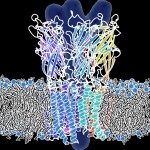Lien vers Pubmed [PMID] – 12662932
Lien vers HAL – Cliquez ici
Lien DOI – 10.1016/s0022-2836(03)00202-x
J Mol Biol. 2003 Apr 11;327(5):1077-92.
Mycobacterium tuberculosis TMP kinase (TMPK(Mtub)) represents a promising target for developing drugs against tuberculosis because the configuration of its active site is unique in the TMPK family. To help elucidate the phosphorylation mechanism employed by this enzyme, structural changes occurring upon binding of substrates and subsequent catalysis were investigated by protein crystallography. Six new structures of TMPK(Mtub) were solved at a resolution better than 2.3A, including the first structure of an apo-TMPK, obtained by triggering catalysis in a crystal of a TMPK(Mtub)-TMP complex, which resulted in the release of the TDP product. A series of snapshots along the reaction pathway is obtained, revealing the closure of the active site in going from an empty to a fully occupied state, suggestive of an induced-fit mechanism typical of NMPKs. However, in TMPK(Mtub) the LID closure couples to the binding with an unusual location for a magnesium ion coordinating TMP in the active site. Our data suggest strongly that this ion is required for catalysis, acting as a clamp, possibly in concert with Arg95, to neutralise electrostatic repulsion between the anionic substrates, optimise their proper alignment and activate them through direct and water-mediated interactions. The 3′-hydroxyl moiety of TMP, critical to metal stabilisation, appears to be a target of choice for the design of potent inhibitors. On the other hand, the usual NTP-bound magnesium is not seen in our structures and Arg14, a P-loop residue unique to TMPK(Mtub), may take over its role. Therefore, TMPK(Mtub) seems to have swapped the use of a metal ion as compared with e.g. human TMPK. Finally, TTP was observed in crystals of TMPK(Mtub), locked by Arg14, thus providing a structural explanation for the observed inhibitory effect of TTP putatively involved in a mechanism of feedback regulation of the enzymatic activity.

